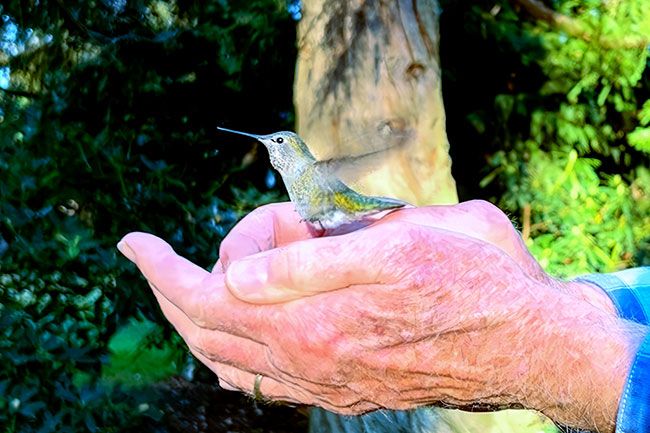Birds' brainpower a wonder to behold


April 15 was a special day during our years living in a remote corner of Alaska.
As we anxiously awaited spring, we rushed to the post office to file our taxes. But much more importantly, it was the day the hummingbirds returned.
Hovering in the exact same spot where our feeder hung the previous summer, I spotted a male Rufous hummingbird. He seemed to be saying, “Hey, I just flew thousands of miles from Mexico, and I’m starving!”
How did he remember this speck of landscape and find his way back when it’s freezing cold and the ground is covered in snow?
I called my friend in Juneau, Bob Armstrong, author of “Guide to the Birds of Alaska.” He responded, “Good question, Peter. Perhaps you can find out.”
And with that, I rushed to put out a feeder for our tired tropical traveler.
Here in Oregon, the ubiquitous Anna’s hummingbirds that grace our feeders year-round were originally a southwestern desert species.
In “Birds of Oregon,” first published in 1940, Anna’s hummingbird was not even included. Portland Audubon reported the first confirmed sighting of an Anna’s in Southern Oregon in 1944.
The proliferation of exotic plants, sugar feeders and warm winters all contribute to their northern expansion. Today, Anna’s have made it all the way to Alaska.
Hummingbirds are the smallest of all birds. They are found only in the Americas.
There are a remarkable 366 known species, most found in tropical Central and South America. Just 15 species of hummers live and breed in the U.S.
If you visit southeastern Arizona, you may find a dozen species of brilliantly colored hummers near the Mexico border. We spent a week at the Paton Center for Hummingbirds in the border community of Patagonia, where we added many species to our life list.
A flock of hummers is known as a glitter or shimmer.
They beat their wings up to 70 times per second, hover in flight and can even fly backwards. And the tiny Bee hummingbird, native to the Caribbean, weighs less than a penny.
Hummingbirds live in the high-energy fast lane. They drink nectar from feeders by moving their grooved tongue in and out about 10 times per second.
They can consume up to double their body weight in a single day. Their tiny hearts pump more oxygen-rich blood per minute than any mammal.
A thoroughbred race horse at full gallop has a heart rate of about 230 beats per minute. During flight, a hummingbird’s little heart pumps at an astonishing 1,250 beats per minute.
These tiny jewels endure winter’s cold nights by lowering their body temperature from a scorching 110 degrees Fahrenheit to a chill 40 degrees, and reducing their metabolic rate accordingly. Similar to hibernation, this survival strategy is called torpor.
Male hummingbirds feature dazzling iridescent feathers for flashy territorial and courtship displays. To impress discerning females, male Anna’s climb more than 100 feet, then swoop to the ground at 60 mph, generating a buzzing sound with their tail feathers before swooping back up in a steep climb.
Hummingbird nests are soft, compact cups not much larger than a golf ball. They feature spongy floors and elastic sides that stretch as chicks grow.
The nest is elegantly woven with plant fiber, leaves, twigs and spider silk to bind and anchor it in place. I’ve even seen an Anna’s collect fur for her nest from brushing Raven, my Flat-Coated Retriever.
The female usually lays two eggs about the size of a white navy bean. She incubates them for about 15 to 18 days.
Juvenile hummingbirds leave the nest, called fledging, 18 to 28 days after hatching. Moving on to adulthood, they may live for eight to 12 years.
We hang two feeders out of direct sight from one another, as a male will attack all interlopers. A female Anna’s driven off the feeder by a male once hit my window and fell to the ground, stunned.
They can quickly go into shock as their body temperature drops. I have rescued many birds by gently holding them for a few minutes, until they are ready to resume flight.
We clean our feeders weekly, replacing the solution with filtered water and plain sugar at a ratio of 4 parts water to one part sugar. Red dye, honey and moldy sugar water can prove lethal, so care must be taken.
In the late 1960s, researchers at Rockefeller University analyzed how birds learn their songs. They discovered that seasonal and hormonal changes in some species correlated with thousands of new neurons added every day to the avian brain.
Previously considered impossible in adults, this phenomenon, called neurogenesis, is actually widespread throughout the avian forebrain, research now shows.
Every autumn, chickadees gather seeds and store them in hundreds of hiding places. Over the winter, they re-visit their cache to feed.
The chickadee’s spatial memory is remarkable. What happens inside the tiny songbird’s brain is even more amazing.
As the chickadee gathers and stores seeds, its hippocampus, the part of the brain responsible for spatial organization and memory, expands in volume about 30 percent through the addition of new neurons. Songbirds are the first vertebrates known to display such adult neurogenesis.
Clark’s Nutcracker is a Corvidae related to the North American crow. They reside along the crest of the Cascades, usually above 4,000 feet.
Nutcrackers are very common at Crater Lake, and they may have the animal world’s keenest memory.
Nutcrackers collect up to 30,000 pine seeds each autumn and carefully bury them across an area of 200 square miles. Over the winter months, they retrieve more than 90 percent of these seeds, despite often heavy snow cover.
Self-recognition and planning for the future are complex skills once considered uniquely human. But magpies, another corvid, exhibit self-recognition in mirror tests.
The cognitive abilities of birds are being increasingly appreciated, as research reveals their unexpected complexity.
Our local azure-blue and highly vocal scrub jays, yet another corvid, display episodic memory — the ability to recall events that take place at a specific time or place.
Parrots, hummingbirds and songbirds all possess the rare skill of vocal learning. African grey parrots even use human words in numerical and relational concepts, abilities once considered unique to humans.
We’ve learned so much from bird behavior and bird brains. Now we know that our resident Anna’s navigates thousands of miles, faithfully returning to the same location to breed.
Adult birds in some species generate new brain cells, so neurogenesis may also be possible in adult humans. This is encouraging news.
The adage “Use it or lose it!” has become proven science. Our aging brains may generate new neurons as we learn new skills.
Guest writer Peter Enticknap studied ornithology at the University of Alaska. He's birded on six continents and worked on avian research projects in Alaska and Africa. He and his wife, Linda, taught ornithology to Alaskan middle schoolers. They co-founded the Alaska Bald Eagle Festival, now in its 28th year, to celebrate the world's largest gathering of eagles each November in Haines, Alaska. He enjoys camping, photography, writing and joining Linda in exploring wild places.









Comments
Juris
Excellent article. Recommend also "Rare Encounters with Ordinary Birds" by Lyanda Haupt, a book that explores the particular talents and habits of birds common on the Pacific Northwest. Also there is a recent NPR story about "honeyguide" birds, birds that will, in response to a particular call, lead honey hunters to trees with honey inside. Birds are awesome and amazing.